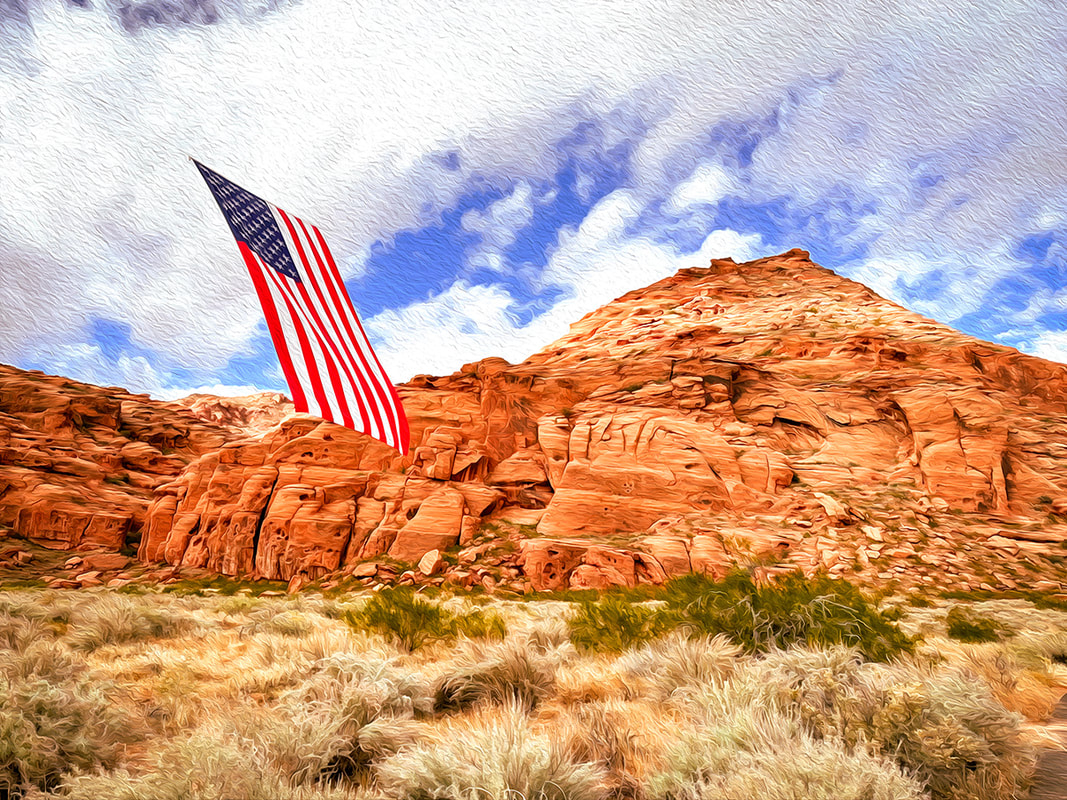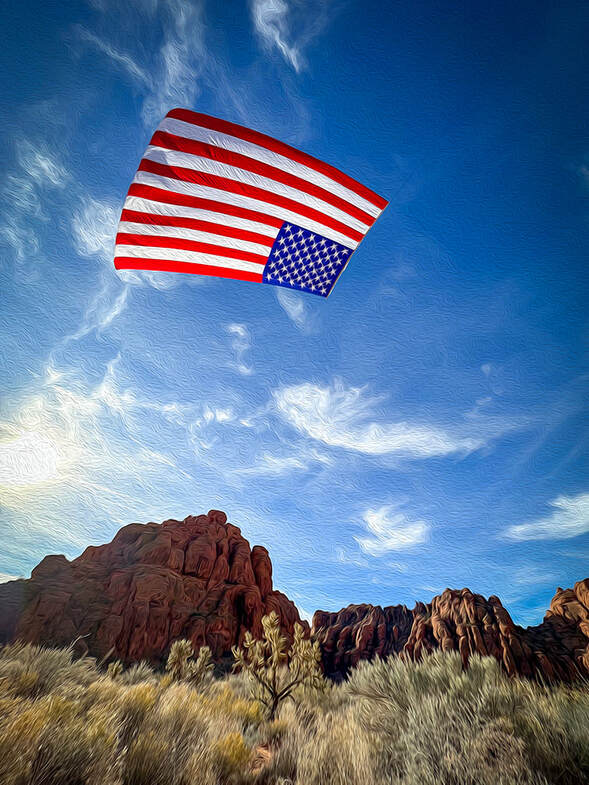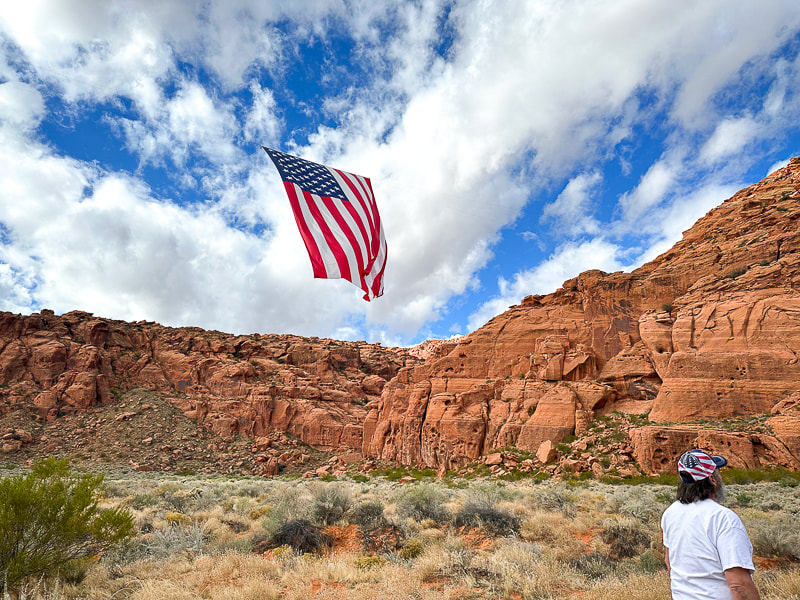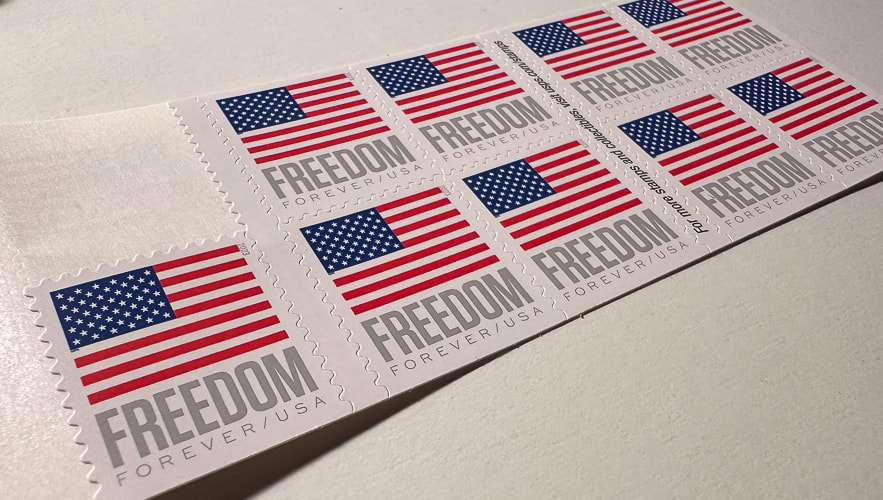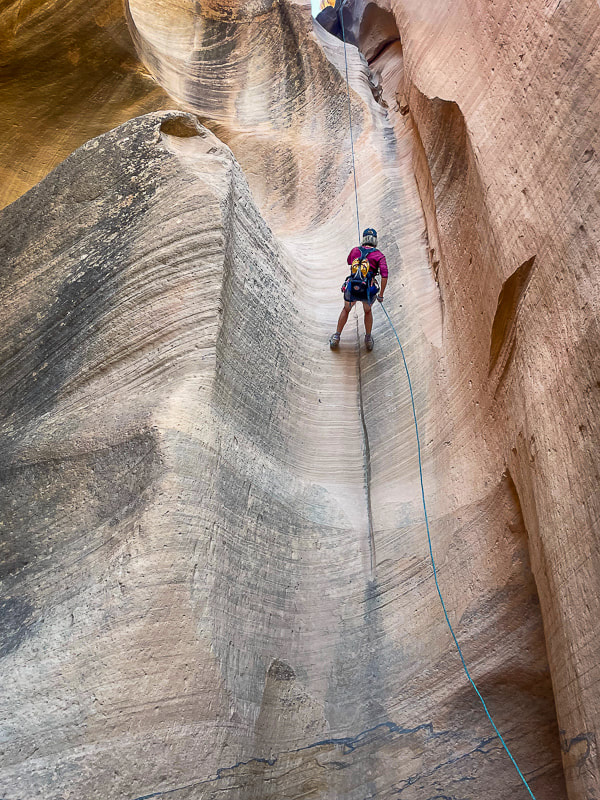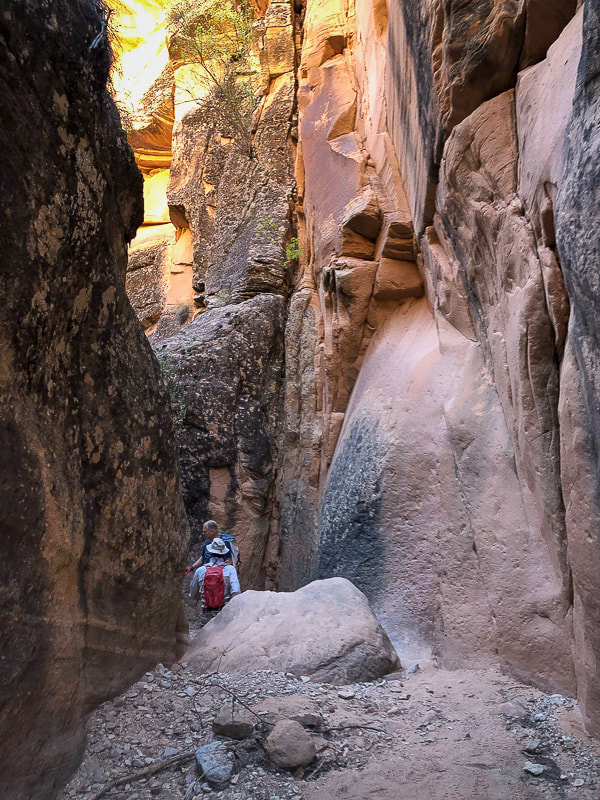|
A stunning sight on Veteran's Day: the largest American flag juxtaposed with the soaring cliffs of Snow Canyon State Park. Lady Liberty, displayed by Follow the Flag organization, at night in Snow Canyon State Park, Utah. Photo by Ann Little Related pages in Explorumentary: Follow the Flag Organization Facts
Check out awesome drone footage in these great videos! Saville Creations: America's Largest American Flag in Snow Canyon St George News Founders: Kyle and Carrie Fox
Motivation: To strengthen Americans' patriotism, a simple idea of inspiring, strengthening and healing people by hanging one of their huge flags in a canyon produced "far more impact than ever anticipated." Other events:
Mission Statement
American Flag Etiquette
Click on video below for awe-inspiring drone video
An unexpected sight greeted Fred and I on our favorite local loop-hike last month in Snow Canyon State Park. Just off Whiptail trail, suspended high in a gap between orange cliffs, hung an enormous American flag, seemingly out of place in in these walls of Navajo Sandstone. People were lined up, taking pictures of this spectacular sight. The flag, in the still air hung vertically, but billowed and rolled with occasional breezes, the bottom edge of it flying gracefully towards the sky. It was suspended in mid-air, with its hanging wires barely visible. I suppose you could ask what visitors were thinking about this huge flag in this gorgeous natural setting and you would probably get different answers, ranging from the emotion of national pride and patriotism to "Wow! That's pretty cool!" to "Why is it hanging here?" For me, my heart swelled because two things that I love were juxtaposed: a symbol of my country and the land of the American West.
Strength, unity, connection, freedom - these are what the American flag is intended to signify. The stripes represent the original 13 colonies that were seceding from the British. The blue canton contains the stars of our 50 states. Blue represents vigilance, perseverance, and justice. White signifies purity and innocence, and red signifies hardiness and valor. This proved to be a good exercise in brushing up on my flag facts, reading America's unique Declaration of Independence, and learning of the efforts going on to unify our country. Pew and Gallup polls show that a record high number of Americans perceive the nation as divided on the most important issues. Maybe Follow the Flag and other organizations can help us see the positive and help us remember the ideals of our country's origin. "...if there’s one impression I carry with me after the privilege of holding for five and a half years the office held by Adams and Jefferson and Lincoln, it is this: that the things that unite us — America’s past of which we’re so proud, our hopes and aspirations for the future of the world and this much-loved country — these things far outweigh what little divides us. And so tonight we reaffirm that Jew and gentile, we are one nation under God; that black and white, we are one nation indivisible; that Republican and Democrat, we are all Americans. Tonight, with heart and hand, through whatever trial and travail, we pledge ourselves to each other and to the cause of human freedom, the cause that has given light to this land and hope to the world." - President Ronald Reagan's Independence Day Speech aboard the USS John F. Kennedy, July 4, 1986.
1 Comment
A drop into the stained and polished Navajo Sandstone slot in this picturesque "beginner" canyon. Sue entering Yankee Doodle on first and longest rappel, ~ 75 feet. photo by Fred Birnbaum Trip Stats Location: Dixie National Forest - Pine Valley Ranger District - ~ 1 hour drive northeast of St. George, Utah, near Leeds. Date: October 15, 2023 Canyon Rating: 3A/B1 (Technical, Dry and Pools, short time). Distance: ~ 2 miles roundtrip (~ 0.8 miles in canyon). Access: from FR031, a 25-mile dirt road connecting St. George and Leeds: best traveled with a 4 WD with moderate clearance vehicle, as this road can get rutted and rough after a rain. The canyoneering portion is just south of this forest road. Start: 37.2361, -113.4528 Links: Paragon Adventure/Canyoneering/Yankee Doodle Hollow Rope Wiki Geology:
Related Posts Brian gets the ropes ready on the next rappel anchor. Our Trip This time Fred and I decided to "leap" out of our comfort hiking zone and try something more challenging: canyoneering! Although Yankee Doodle Hollow is rated as a "beginner" canyoneering hike, rappelling - especially the first drop into the canyon - was a challenge for us. This brief foray into these beautifully-polished and sinuous narrows rated as one of our favorites for 2023. Also on my list of favorites is the "Subway" - Left Fork of North Creek in spectacular Zion National Park, another journey into rock carved by water. My friend Brian from CrossFit Dixie has been canyoneering in this area of southern Utah, including Zion. He invited me on previous canyoneering trips but I was always too intimidated to go. He guided us on this short foray, setting up the ropes on the rappel anchors and instructing us on how to control the rope in our rappel device. He got us all set up with our harnesses and locking carabiners. Brian's friend Jorey, who had never rappelled before, joined us. The joy on his face when he completed the first long rappel into the canyon and overcame his fear of heights was priceless. He was so afraid to take the initial "leap" into the void. Fred and I had learned climbing techniques on a guided Grand Teton hike, but I was still pretty nervous. Canyon Origins Not sure how this canyon got its name. Was it named by miners in the area, or Mormon Leeds settlers? Yankee Doodle Hollow Creek originates from the highlands under the cliffs of the Pine Valley Mountains. This area of southwestern Utah is complicated geologically-speaking, with uplifts, gravity slides, compressional structures (uplift), extensional structures (faults), and more. One look at the Geologic Map of St. George area and you might agree. So many rock units from Permian time (300 million years ago) until present. Although a shorter and shallower canyon compared to legendary Zion canyons, Yankee Doodle Hollow still has the pretty curved and smooth cross-bedded walls of spectacular Navajo Sandstone - one of nature's works of art. You don't have to get a permit or arrange for shuttles between canyon entry and exit points, like you have to do in Zion. After we had completed all of the down-climbs we did a Class 3 steep slick rock scramble out of the canyon, slightly rubber-stained from many climbing shoes, as it opened up to the left. The Class 2 path up to the rim was discernible. If you keep going past this exit point, you continue walking down Yankee Doodle Hollow, you intersect with Heath Wash, where you would take a left (north) onto Heath Trail, which takes you back to FR031. Fun stuff! Glad Brian finally got me out there. Hopefully we can do more canyoneering....but Fred and I always default to the above-ground adventures! Thank-you Brian for getting us out of our Comfort Zone! Push the envelope - Keep on Exploring! A portion of the GEOLOGIC MAP OF THE ST. GEORGE AND EAST PART OF THE CLOVER MOUNTAINS 30' X 60' QUADRANGLES, WASHINGTON AND IRON COUNTIES, UTAH by Biek, R.F., et al. The pink rock unit at top-center of photo is Pine Valley Mountains (quartz monzonite laccolith). The Jurassic Navajo Sandstone is the light-green unit that presents as a kind of semi-circle around the base of Pine Valley Mountains, a much older unit, that is the main rock seen in Zion National Park. The City of St. George is located at the bottom of the map. We are going to be down there soon - WOW! Jorey (canyoneering newbie) left, and Brian on the right, getting us all set up. The first (and only) long rappel into the canyon, ~ 75', with two anchors. Photo by Fred Birnbaum Brian getting next down climb ready. Fred on a short rappel. Canyon exit: steep smooth sand stone on the left, fractured rock falls on the right. Pretty steep slick rock on the exit. Wandering around afterwards in Brian's RZR side-by side ATV. Pine Valley Mountains (monzonite porphyry laccolith) to the north. It's highest point is Signal Peak at 10,369'. Reference
Biek, R.F. 2010. Geologic Map of the St. George and East Part of the Clover Mountains 30' x 60' quadrangles, Washington and Iron Counties, Utah. Utah Geological Survey. |
Categories
All
About this blogExploration documentaries – "explorumentaries" list trip stats and highlights of each hike or bike ride, often with some interesting history or geology. Years ago, I wrote these for friends and family to let them know what my husband, Fred and I were up to on weekends, and also to showcase the incredible land of the west.
To Subscribe to Explorumentary adventure blog and receive new posts by email:Happy Summer!
About the Author
|






